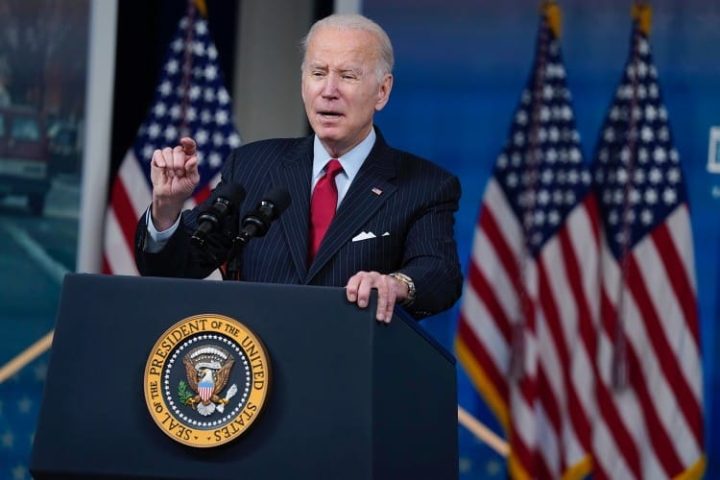
The Biden administration has asked a federal appeals court to lift a stay on its mandate that larger employers ensure their workers are either vaccinated for COVID or get tested weekly, claiming that any delay in enforcing the rule “would likely cost many lives.”
According to the Emergency Motion to Dissolve the stay (pdf) filed by the administration on Tuesday, COVID-19 is an extremely deadly disease, and only forced vaccinations could save the workplace from dangerous outbreaks.
Per the text,
COVID-19 has killed more than 750,000 people and caused “serious, longlasting, and potentially permanent health effects” for many more…. Significant exposure and transmission, including numerous workplace “clusters” and “outbreaks,” are occurring in workplaces throughout the Nation.
The motion claims that the Emergency Temporary Standard (ETS) issued by the Labor Department’s Occupational Safety and Health Administration (OSHA) on November 5 will save “over 6,500 worker lives and prevent over 250,000 hospitalizations over the course of the next six months.”
The U.S. Court of Appeals for the Fifth Circuit temporarily blocked the ETS on November 6, saying it raised “grave statutory and constitutional issues.” On November 12, the court reaffirmed its stay against OSHA’s mandate, further detailing its numerous legal flaws.
First of all, the administration claims that COVID-19 is both a “physically harmful/toxic agent” and a “new hazard” that constitutes a “grave danger”
at the workplace:
OSHA described myriad studies showing workplace “clusters” and “outbreaks” and other significant “evidence of workplace transmission” and “exposure.” And OSHA explained that “employees can be exposed to the virus in almost any work setting.”
As for the “new danger,” the motion says the virus “was unknown in the United States until early 2020.”
The court, by contrast, suggested that such a term does not constitute novelty of the threat to justify the emergency. The judges pointed out that OSHA waited nearly two years before declaring a workplace emergency due to COVID. Per the order,
The Mandate’s stated impetus — a purported “emergency” that the entire globe has now endured for nearly two years, and which OSHA itself spent nearly two months responding to — is unavailing as well. And its promulgation grossly exceeds OSHA’s statutory authority.
To that argument, the administration replied that changing circumstances, including businesses reopening, rollout of “federally approved” COVID vaccines and tests, and the “rapid rise to predominance of the Delta variant” explain the delay.
The Fifth Circuit also noted that OSHA’s purview is strictly limited to addressing hazards that are directly related to workplaces, and has no business addressing “dangers” that are “widely present in society.” The court stated that COVID-19 falls into the latter category, arguing that an airborne virus that is “not life-threatening to the vast majority of employees” can infect people in any place.
The administration disagrees, and gives an example of OSHA requiring “precautions for bloodborne pathogens, which can be contracted outside the workplace, and has long imposed workplace sanitation and fire rules, even though such concerns are not workplace-specific.” The motion added that “the nature of workplaces is that employees come together in one place for extended periods and interact, thus risking workplace transmission of a highly contagious virus,” which presumably explains why COVID should be dubbed a “workplace hazard.”
The court argued that OSHA’s standard, which only applies to large employers, made the ETS “underinclusive:”
The most vulnerable worker in America draws no protection from the Mandate if his company employs 99 workers or fewer.
This implies, says the court, that the agency was executing President Biden’s plan of boosting the nationwide vaccination rate rather than promoting workplace safety:
After the President voiced his displeasure with the country’s vaccination rate in September, the Administration pored over the U.S. Code in search of authority, or a “work-around,” for imposing a national vaccine mandate. The vehicle it landed on was an OSHA ETS.
The claim was supported by White House Chief of Staff Ron Klain’s post on social media admitting the standard was “the ultimate work-around for the Federal govt to require vaccinations.”
While ignoring the court’s statement about OSHA doing dirty work for President Biden, the motion said OSHA plans to make the standard more “inclusive” by eventually expanding it to smaller businesses. It said,
Due to the “unique” and exigent “occupational safety and health dangers presented by COVID-19, OSHA is “proceeding in a stepwise fashion” by applying the Standard to “companies that OSHA is confident will have sufficient administrative systems in place to comply quickly.” OSHA is concurrently obtaining “additional information to determine whether to adjust the scope of the ETS to address smaller employers.”
The court said that OSHA’s mandate raises potential issues under the Commerce Clause and nondelegation doctrine, noting that the U.S. Congress, when establishing OSHA, did not intend “to authorize a workplace safety administration in the deep recesses of the federal bureaucracy to make sweeping pronouncements on matters of public health affecting every member of society in the profoundest of ways.”
Yet again, the administration disagreed, claiming OSHA’s ETS was issued within an “intelligible principle,” or reasonable legal standards for when that power [granted to the agency by the Congress] may be exercised,” since COVID, as argued above, poses a “grave danger” to workers.
As for the ETS violating the Commerce Clause, OSHA, arguably, cannot legally regulate noneconomic inactivity, i.e., the individual decision to forgo vaccination, per the court order.
The administration insists that it can. Saying that just like “many federal laws that regulate business conduct, the standard prescribes rules concerning how to engage in that commercial activity, and those rules sometimes require taking actions” such as imposing “workplace safety and health standards.”
Last week, a total of 34 challenges to the mandate filed in 11 courts, including the Fifth Circuit cases, were consolidated and assigned by lottery to the Sixth Circuit Court of Appeals, which the administration is now asking to override the other court’s order.





